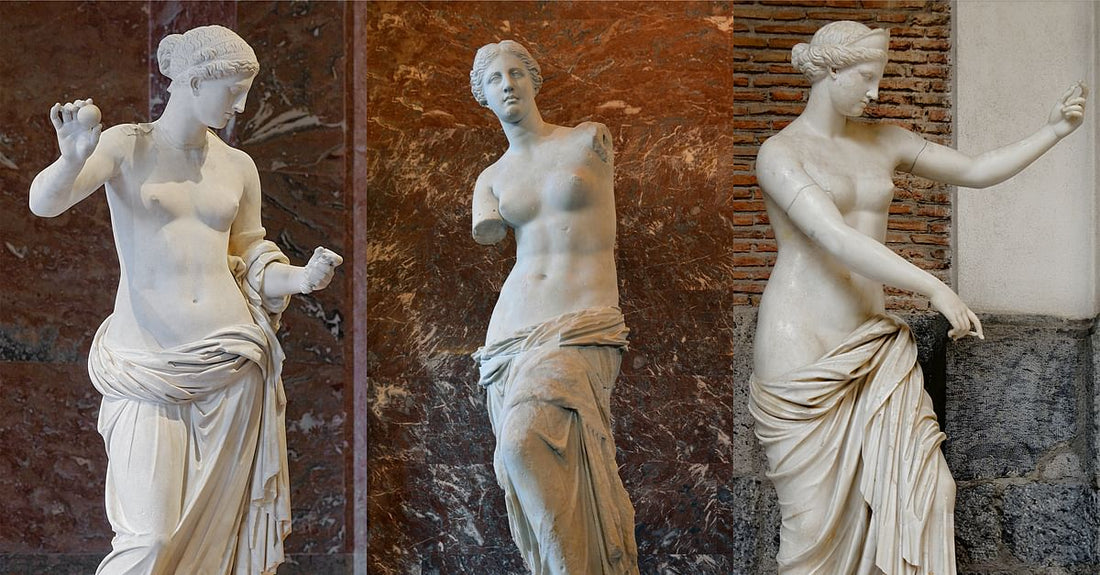At the Louvre, the illustrious Venus de Milo stands in a prime area of the gallery. She overlooks visitors at 6 foot 8 inches of Parian marble. First discovered on the Greek island Milos in 1820, the sculpture depicts the goddess Venus with a bare torso and flowy drapery along her bottom half. Though the sculpture has significant damage, including missing arms and its original plinth, it has been heralded as the timeless epitome of feminine beauty. Today, the Venus de Milo is one of the most recognizable Hellenistic sculptures. She has been the inspiration for numerous artists and their work, including Salvador Dalí’s Venus de Milo with Drawers and The Hallucinogenic Toreador, as well as Paul Cézanne’s Study of “Venus de Milo” sketch.

The sculpture also lives on in the intersection of art and politics. Upon its discovery, the sculpture was utilized as a propaganda tool for the French nation to reclaim its prominence in the art world. After Napoleon Bonaparte’s collection of looted art was returned to their respective countries of origin in the nineteenth century, the Louvre had lost many iconic Hellenistic and classical sculptures. After the discovery of the Venus de Milo, French authorities and the Louvre rocketed the statue into fame with nationalistic propaganda, with the hope that the statue being presented in France would restore French national pride.

It is easy to see why the Venus de Milo is such a popular artwork. The statue is a magnificent display of feminine beauty and human skill. It also invokes mystery and conspiracy with its multiple tales of discovery, speculations of its original appearance, and the grand advertising scheme that led to its proliferation as a cultural icon. To look at her is to gaze upon idyllic beauty and aesthetic charm.
In our own society, beauty holds us equally accountable and fascinated. We are often victims of standards of beauty that seem to determine our worth. We gaze at archetypes of beauty with enchantment. For many, beauty is a source of power that is endlessly reinvented and reassigned.
In art, we seek the idyllic and the understandable. Often, the understandable aspects of art are tragic and painful, while the idyllic is unattainable. In his own reimagination of Venus de Milo, French entrepreneur and artist Greg Lansky reconstructed Venus as a woman in 2023. Lansky’s Venus, titled Algorithmic Beauty, proudly displays plastic surgery scars while extending an arm with an iPhone in a clutch. The statue stands at the same height as its antecedent and is sculpted from marble.


According to an Instagram post sharing the sculpture, the piece’s title is derived from Lanksy’s belief that AI algorithms have a divine power over human existence. These algorithms, Lanksy claims, invent and influence modern beauty standards in a damaging cycle that promises that followers of such standards will be rewarded with digital engagement and love. Lansky also writes that he drew inspiration from the Venus de Milo because he sought to portray a subject that is “beyond the reach of humans”. Lansky adds,
“I also chose the Venus de Milo because it is the personification of our “Fake it till you make it era”. When it was discovered in 1820, the Louvre museum actually broke a piece off the sculpture to pretend it was made by a more prestigious artist and time period. By the time people found out it was already the most famous sculpture in the world and no one cared. Maybe the Venus de Milo is the best metaphor for our social media era; A fictional Goddess hyped with marketing and lies but that we all want to take a picture with.”


Lansky’s recent creation is another case that illustrates the interaction between ancient and contemporary art. Centuries later, artists are still fascinated with ancient statuary, exemplifying the art form’s timeless relevance to the experience of being human.
©ArtRKL™️ LLC 2021-2023. All rights reserved. This material may not be published, broadcast, rewritten or redistributed. ArtRKL™️ and its underscore design indicate trademarks of ArtRKL™️ LLC and its subsidiaries.





